Realtors have their location, location, location mantra that they recite as the factor that contributes most to a property’s value. A similar thing could be said for predicting how well a plant will do in the garden. Even if you follow the basic instructions on a plant’s requirements–basic information about its preferences for sun or shade, for instance, or its preferences for more or less water–lots of other variables can figure in the equation for how well the plant will do for you.
Here are a couple pairs of pictures of Barbie posing by plants in the garden so you can get a sense of scale. In each pairing, the plants next to Barbie went into the ground on the same day. But you can see how much difference the location of the transplants made in how much they liked their new homes.
First is Barbie next to plants of Rudbeckia hirta ‘Green Eyes’ that were planted last Fall:
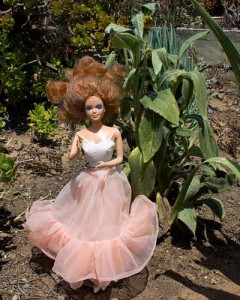
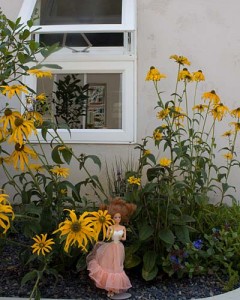
In the first location, in the front yard, the plant is hanging on but not happy. It gets sun virtually all day and gets watered infrequently. The soil is fairly dense clay with minimal amendments, and the location has no mulch. With multi-year-old plantings nearby, much of the water is sucked up by roots of the more established plants.
In the second location, the plants are doing much better. The exposure is East-Northeast, meaning the plants get sun in the morning, with some additional boost reflected off the house. Watering is generally about once a week. The soil is clay, similar to the first location, but it received a few amendments at the time of planting. A layer of dark pebbles serves as mulch. Though the plants are next to a shrub, the shrub was planted at the same time and the rudbeckis, meaning the roots from the shrub weren’t running through the area and didn’t interfere with these plants getting established.
My conclusion? Though frequently considered a fairly drought-tolerant plant, rudbeckias do appreciate some moisture. Competition from nearby plantings can have a dramatic effect on how well a newly-introduced will do. Increasing the watering of the little front-yard plant could give it a better chance, and doing a little root-pruning with a shovel about a foot away from the base of the plant would help reduce competition from its thirsty neighbors. Some sort of mulch could help preserve soil moisture in this very exposed location.
Next we see Barbie posed next to plants of the tomato, Cherokee Purple:
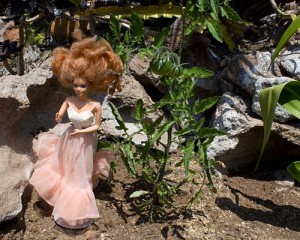
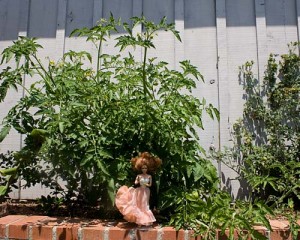
Both locations face West-Southwest, assuring strong sun from before noon into late afternoon. Both locations receive light-to-moderate watering. The soil in the first spot is moderately heavy garden soil amended with organics. The location is part of a retired fishpond where the concrete on the bottom had holes drilled into for drainage, making this in essence a large container set into the ground. The soil is probably less than one foot deep, and the spot isn’t mulched.
The second plant is in a raised bed with deep, sandy soil that wasn’t amended before the plant went in. The plant benefits from a light layer of wood-chip mulch.
The tomato appears to appreciate a deep soil that would encourage a strong root system. Since I can’t do anything now to increase the depth of the soil in the first situation or to improve its makeup, some mulching could help keep the moisture level more uniform. Also, since the plant is essentially containerized, applications of low-nitrogen fertilizer would help equalize its chances for success with the plant that can set its roots deep and wider in search of nutrients. For next year’s plantings, replacing the current soil with a mix more appropriate for containers could also let the plantings fare better.
After this photo shoot in the garden Barbie had to come back inside for a rest. It’s tough being a supermodel.
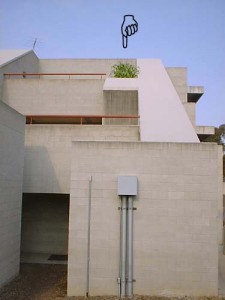











 The Kyocera trees seem to be slanted more to corporate environments, and besides I find them more than a little monolithic and overwhelming. Would you want these in your garden? But something along these lines could be practical, good for the environment and attractive. Sounds like a job for an artist or designer instead of an engineer…
The Kyocera trees seem to be slanted more to corporate environments, and besides I find them more than a little monolithic and overwhelming. Would you want these in your garden? But something along these lines could be practical, good for the environment and attractive. Sounds like a job for an artist or designer instead of an engineer…